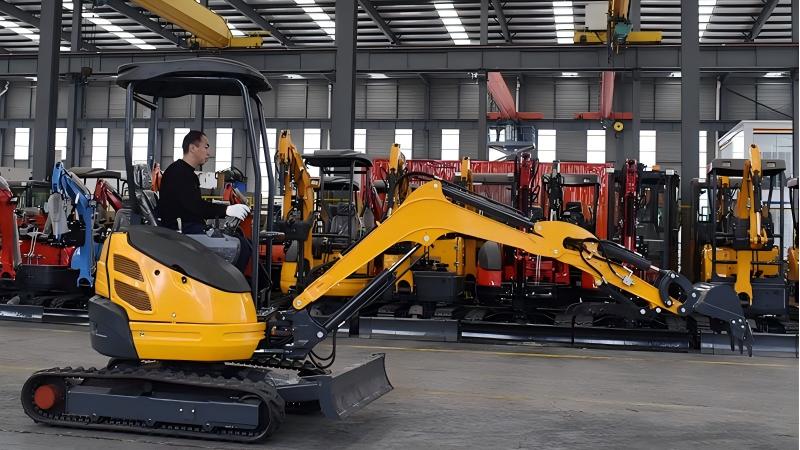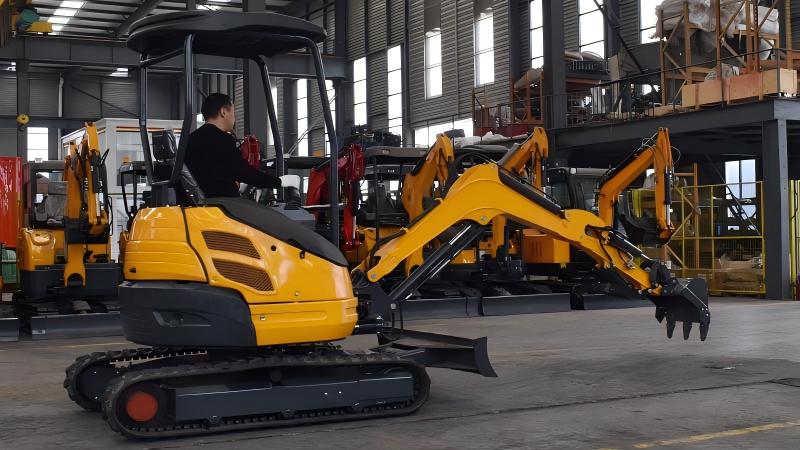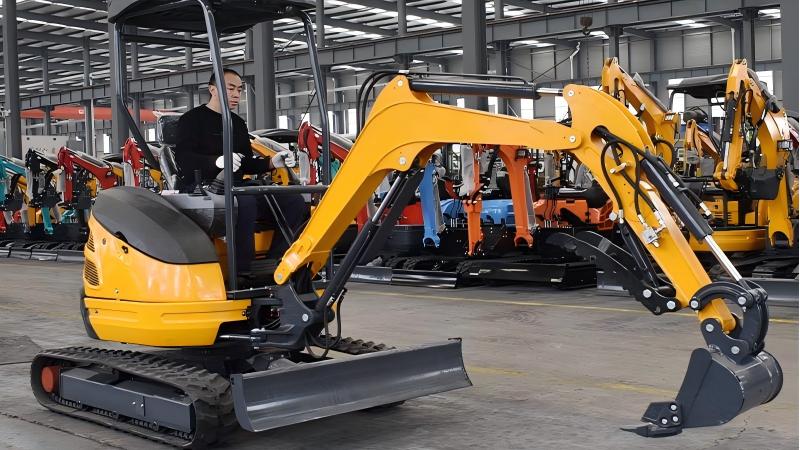Mini excavators are prized for their compact size and versatility, making them ideal for work in confined spaces where larger machinery simply cannot operate. One of the most common questions from homeowners, landscapers, and contractors is whether these machines can fit through a standard gate. The answer is nuanced, as it depends on the specific dimensions of both the excavator and the gate.
Understanding Mini Excavator Widths
Mini excavators come in various sizes, typically categorized by their operating weight, ranging from less than 1 ton (micro excavators) to around 8 tons. Their width is a critical dimension when considering access.
Micro Excavators (Under 1.5 tons): These are the smallest machines and are often specifically engineered with retractable tracks or a very narrow fixed chassis to fit through standard doorways and gates.
Typical Width: 700 mm to 1,000 mm (approximately 27.5 inches to 39 inches).
Examples: Kubota K008-3, Bobcat E10, Caterpillar 300.9D. Many of these models can retract their tracks to achieve a narrower width, sometimes as little as 700-750 mm (27.5-29.5 inches), making them ideal for passing through standard garden gates or even interior doorways.
Small Mini Excavators (1.5 to 3 tons): These are more robust but still compact.
Typical Width: 1,000 mm to 1,500 mm (approximately 39 inches to 59 inches).
Access: Many gates might be too narrow for these models without modifications. Double gates or wider custom gates would be required.
Medium Mini Excavators (3 to 5 tons):
Typical Width: 1,500 mm to 1,900 mm (approximately 59 inches to 75 inches).
Access: Unlikely to fit through standard gates. These typically require dedicated access roads or very wide openings.
Large Mini Excavators (5 to 8 tons):
Typical Width: 1,900 mm to 2,300 mm (approximately 75 inches to 90 inches).
Access: Definitely not designed for standard gate access.
Standard Gate Dimensions
The term "standard gate" can be ambiguous, but generally refers to:
Standard Pedestrian Gates (Residential): These are commonly 900 mm (approximately 36 inches or 3 feet) wide. Some older or custom gates might be narrower (e.g., 800 mm / 31.5 inches), while some modern ones might be slightly wider.
Standard Double Gates (Residential/Light Commercial): Often designed for vehicle access, these can range from 2,400 mm to 3,600 mm (approximately 8 feet to 12 feet) wide, though smaller versions around 1.8 meters (6 feet) are also common.
Commercial/Agricultural Gates: These are typically much wider, often exceeding 3 meters (10 feet) to accommodate trucks and larger machinery.
The Critical Measurement: Machine Width vs. Gate Opening
To determine if a mini excavator will fit, you must compare the narrowest point of the excavator (usually the retracted track width or fixed chassis width) with the actual clear opening of the gate.
Key Considerations for Measurement:
Excavator Width: Always refer to the manufacturer's specifications for the "overall width" or "track width." If the model has retractable tracks, find the retracted width as this is the minimum possible width for access.
Gate Opening: Measure the clearance between the gate posts (or between the post and the fixed wall/fence) when the gate is fully open. Don't just measure the gate leaf itself. Account for hinges, latches, or any other protrusions that might reduce the effective opening.
Clearance: It's highly recommended to have at least 50 mm (2 inches) of clearance on each side (total of 100 mm or 4 inches) between the widest point of the excavator and the narrowest point of the gate opening. This provides a safety margin for maneuvering and prevents damage to both the machine and the gate posts. Attempting to squeeze through with minimal clearance greatly increases the risk of damage.
Example Scenario:
A Kubota K008-3 mini excavator has a minimum operating width of 700 mm (27.5 inches) with its tracks retracted.
A standard residential pedestrian gate is 900 mm (36 inches) wide.
In this case, the K008-3 would fit comfortably through the gate with 200 mm (7.8 inches) of clearance (900mm - 700mm).
However, if you have a slightly larger mini excavator, like a Bobcat E17 (minimum width around 980 mm / 38.6 inches), it would be a very tight squeeze (980mm vs 900mm) through a standard 900mm pedestrian gate, or potentially not fit at all, given that the E17 is actually wider than 900mm. It would require a wider gate or an alternative access point.
Features that Aid Gate Access
Several design features in mini excavators enhance their ability to navigate narrow spaces:
Retractable Tracks (Variable Undercarriage): This is the most significant feature for gate access. The ability to hydraulically retract the tracks allows the machine to temporarily reduce its overall width. Once through the narrow opening, the tracks can be extended again for improved stability during operation. This feature is predominantly found on micro and very small mini excavators (typically under 2 tons).
Zero Tail Swing (ZTS): While not directly related to gate width, ZTS models are designed so that the counterweight does not extend beyond the width of the tracks when the upper structure rotates. This is crucial for operating in tight spaces once the excavator is inside a confined area, preventing collisions with walls or fences.
Foldable ROPS/Canopy: Some mini excavators, particularly the smaller ones, have a foldable Roll-Over Protective Structure (ROPS) or canopy. While this primarily helps with transport height or working in low-headroom areas (like basements), it can also sometimes assist if a gate has an overhead beam or limited vertical clearance.
Removable Canopy/Seat: On very small models, the canopy or operator's seat might be easily removable to further reduce height for extremely low overhead clearances.
Practical Considerations for Gate Access
Beyond just the width, there are other practical points to consider when trying to get a mini excavator through a gate:
Gate Material and Stability: Ensure the gate and its posts are sturdy enough to withstand accidental bumps. A flimsy wooden gate might be easily damaged.
Ground Conditions: Mud, soft ground, or uneven terrain near the gate can make maneuvering difficult and increase the risk of getting stuck or damaging the gate.
Approach Angle: A straight approach is always best. Trying to navigate a tight turn immediately before or after a narrow gate opening significantly increases the difficulty and risk of collision.
Operator Skill: An experienced operator is far more likely to navigate a tight squeeze successfully than a novice. If you're renting, consider if you have the necessary experience.
Protecting Surfaces: If the excavator needs to drive over a lawn or delicate paving to reach the gate, consider using plywood or ground protection mats to prevent damage.
Power Lines/Overhead Obstructions: Always be aware of any overhead power lines, tree branches, or building overhangs when maneuvering through gates, especially if the gate leads to a confined are
Alternatives if the Excavator Won't Fit
If your chosen mini excavator simply cannot fit through the existing gate, consider these alternatives:
Temporary Gate Removal: If possible, temporarily remove the gate leaves and possibly even one of the posts to create a wider opening. This is a common solution for residential projects.
Alternative Access Point: Is there another way onto the property? Perhaps a wider access road, an open fence line in another area, or even a section of removable fencing.
Smaller Excavator Rental: If access is paramount and permanent modifications are not feasible, you might need to rent a smaller "micro" excavator that is guaranteed to fit.
Manual Labor/Other Equipment: For very small tasks where machine access is impossible, manual labor or smaller, handheld power tools might be the only option.
Conclusion
In summary, yes, many mini excavators, particularly the smaller models with retractable tracks, are designed to fit through standard gates. However, it is absolutely critical to accurately measure both the excavator's narrowest width and the gate's clear opening before attempting access. Always allow for a safety margin and consider the other practical factors like ground conditions and operator skill. Taking these precautions will ensure safe and damage-free entry for your mini excavator, allowing you to leverage its compact power in tight spaces.
Post time:Sep-25-2020



